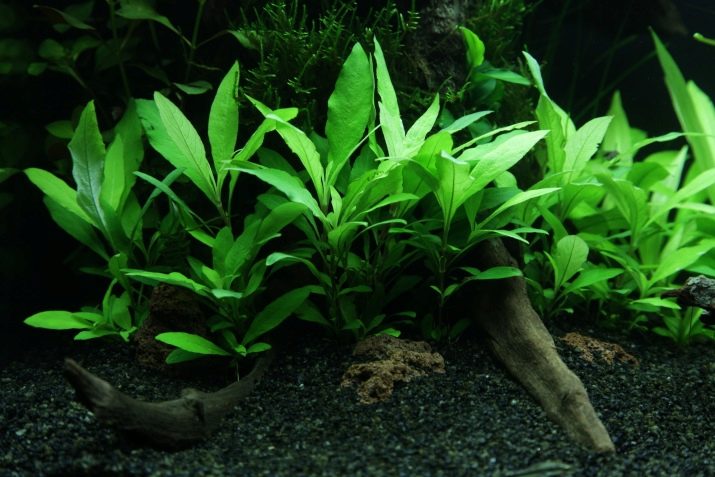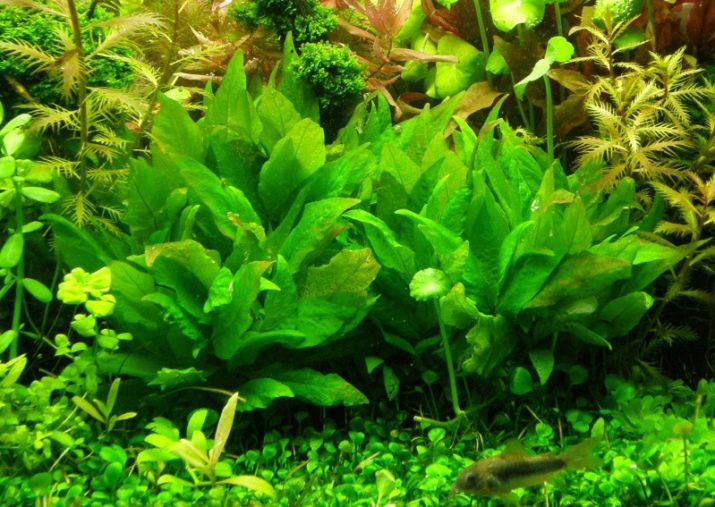For a rather long period, an aquarium plant Schisandra has been a popular resident of the aquarium. With the help of this plant, each fish owner is able to easily create his own ecosystem. Aquarium lemongrass is quite unpretentious in content, is distinguished by its rapid growth and special beauty. You will learn about all other features of the plant and much more from our article.

Features
Schisandra - one of the types of aquarium plants - got its unusual name due to the special smell that it emits. The aroma itself is weakly expressed and remotely resembles a lemon. But it is also worth noting that there is another name for this plant - the Indian bog or Nomaphila stricta. He comes from Asia, more precisely, from its southeastern part.
One of the main functions of the plant, in addition to aesthetic, is the oxygenation of the aquarium space. In addition, large leaves of the plant can perfectly serve as a shelter for fish. It is also worth noting that This vegetation is able to grow both in water and on land, provided that humidity is optimal for growth.

Moreover, in air, the growth rate can be several times faster.
This plant is able to please the eye for a long time, since under good conditions, an aquarium magnolia vine can grow for 365 days a year by about 10 centimeters in one week. We draw your attention to the fact that if the plant growth is not controlled, then it can grow greatly and take up more space in the aquarium than it should.

Appearance
If you want to get such an aquarium plant as lemongrass, then you should familiarize yourself with its main external characteristics.
The standard maturation of most varieties of this plant is approximately 30 centimeters. In this case, the stem itself is quite thick and darker in comparison with the foliage. Leaves may be different depending on the species. The most common are oval and pointed leaves. Their length can reach up to 12 centimeters, and a width of about 4 centimeters. The outer side of the leaves is usually a light green hue, and the back is silver.

This is a description of the external characteristics of a plant that grows in water. As for the species that grows on land, its appearance is slightly different: the foliage is more embossed, and also has distinct veins along the entire length; during flowering, a small blue flower appears.
It is by such characteristics that you can determine that your "pet" is not susceptible to any disease and feels comfortable in its environment. If any changes are observed in the shape of the stem, foliage, or their color does not correspond to the above characteristics, then measures must be taken. Most often, problems may lie in the following aspects:
- water;
- the soil;
- lighting;
- temperature;
- compatibility with other plants and fish.

If all these factors are taken into account, then your aquarium magnolia vine will be able to fully grow and delight you for a long time.
Kinds
A large number of varieties of aquarium schizandra are known, but only some species are used to decorate a home aquarium. These include several varieties of plants.
- Narrow-leaved. The main distinguishing feature of this plant is the highest growth rate compared to other species. Note that in a fairly mild aquatic environment this species may discard foliage, and the stem will be bare on several upper tiers. And also the plant likes a large amount of light, replacing a small amount of water in the aquarium (1-2 times a week).

- Dwarf. This type of aquarium lemongrass is distinguished by its rather short epicotyls and very dense foliage, which is located close to each other. It is also worth noting that this type of aquarium plant is beginning to gain popularity among aquarium lovers.

- Loosestrife. It is considered one of the most unusual species, since the same species can look completely different depending on the place. The features include a thin and flexible stem, as well as narrow and very thin leaves that can wriggle downstream. The plant loves bright light and does not tolerate liquid forms of fertilizer. In addition, this variety is able to serve as an indicator of the aquatic environment, you only need to pay attention to the change in foliage of the plant: white plaque - lack of iron; yellowing or rapid death - a lack of nitrates; holes in foliage - lack of calcium.

How to choose?
In order to create an aquarium beautiful and comfortable for your fish to live, algae should occupy some part of its perimeter. They will help to create a beautiful view. Unlike artificial vegetation, living aquarium plants will benefit your pets.
The selection of aquarium algae should be approached with due care. And lemongrass is no exception. To begin with, it is worth noting that algae for the aquarium can be divided into 3 categories according to their location: in the back, in the middle and in front of the aquarium.

Schisandra, as a rule, can be found either in the middle part or in the background of the aquarium (depending on the species).
To choose a good "seedling" for your aquarium, you should pay attention to several external signs. These include several factors.
- The stem should be darker in color compared to foliage. And also it should not be too thin.
- The leaves should look healthy, without any plaque, interspersed. Their color is usually slightly lighter than the stem. Depending on the type of plant, the back side of the leaves may differ in color from the front, this may not always be a bad sign.
- The roots should be at least 2-3 centimeters so that the plant can take root well in the soil of the aquarium. Make sure that the roots are free of any damage.

How to plant?
Even if you have chosen the best specimen for your aquarium, but planted it inappropriately, the plant will not take root and will soon die. That is why it is necessary to take a responsible approach not only to the process of choosing aquarium greenery, but also to its planting.
In order to plant lemongrass correctly, it is necessary to observe some requirements in relation to aquarium soil:
- the thickness of the soil layer should be in the range of 5 to 7 centimeters;
- any base of soil is suitable, since the roots of this plant are very strong and can take root in any soil;
- when transplanting under the root of lemongrass, you need to put a small layer of clay;
- in the soil there must be a concentration of nutrients, silt.

If the soil is favorable for the plant, then this is an application for complete success. However, do not forget about other factors that may contribute to the speedy growth of your lemongrass. Other features that you should pay attention to when landing, include the following factors:
- lemongrass is sensitive to changes in the environment, therefore, after planting, do not use a plentiful amount of fertilizer;
- plentiful light will help the plant to take root faster and contribute to the rapid growth of leaves;
- Schisandra hard to tolerate a large number of sodium ions in water.

In order to grow this type of plant in this kind of environment, you should first place it in a small container with a small amount of water. As soon as you notice the shoots, you can transplant into the ground.
At the same time, do not forget about the thin layer of clay that should be placed in the ground.
Content Rules
Schisandra is a rather attractive and at the same time not very whimsical plant care plant that can grow in the aquarium in your home. This type of plant is intended for growing in large aquariums (from 150 liters). In order for your plant to maintain its pristine attractive appearance, it is necessary to take proper care of it. Everyone knows that the aquarium magnolia vine is prone to very rapid growth, and if you do not want it to occupy most of your aquarium, you need to monitor its size and cut the stem in time, shorten the shoots.

And there are also a number of conditions that will help your “green pet” feel comfortable in its environment.
- The soil. The presence of a clay-peat layer with a width of 5 centimeters is mandatory. Schisandra will feel comfortable in a muddy substrate with fertilizers, which include phosphorus, calcium, magnesium.

- Lighting. It is recommended to grow this type of aquarium plant with 50 Lm of luminous flux per liter of water. It is best to use LED lamps. It is also possible to use fluorescent lamps, however, their replacement should be carried out more often than LED lamps. The shade of light itself must be yellow, otherwise the "pet" will grow too quickly.

Experts recommend providing illumination of the side parts of the aquarium, and the lighting itself should work no more than 12 hours.
- Temperature. The optimum temperature for an aquarium magnolia vine is + 24.28 ° C. If the indicator on the thermometer drops below + 20 ° C, then the algae will slowly grow, and foliage may fall.

- Water. The hardness of the water in the aquarium should be from 8 dGh with an acidity of 7-8.5 pH.In this case, the nitrate index should not exceed 10 milligrams per liter of water. And also every 7 days it is necessary to replace approximately 30% of the water. The new amount of water must meet all of the above parameters. In addition, the movement of water in the aquarium should be moderate, so pay attention to the filter that you install. If its power creates a strong flow, then resort to the use of "flute".

- Compatibility. Schisandra is considered a fairly stable algae, which can displace some other flora. At the same time, do not forget that other plants, for example, pistachia, can affect the growth rate of your lemongrass up. As for the fish, it’s best not to put lemongrass in the same aquarium with nomaphiles, scalars, and ancistruses.


How to propagate?
As for the breeding of this type of plant, it is produced using cuttings. In order to carry out all the processes correctly, you need to follow certain instructions.
First, separate the upper shoots of an already grown Schisandra and plant them in fine soil, pebbles are also sometimes used. When cutting off the upper part, side shoots are obtained, which should also be separated and planted in fine soil or pebbles. Thus, provided that the root and part of the stem are preserved in the soil, you can get an aquarium magnolia vine already with side shoots.

As soon as the process of self-cultivation of the plant ends, you can begin to land your "pet". If you were engaged in multiplying the aquarium magnolia vine yourself at home, then after planting it is worthwhile to closely monitor its “health” for some time so that in case of any problems your plant does not die.

As soon as you notice changes in the appearance of the plant, this is direct evidence that the living conditions of lemongrass do not quite suit him, and you need to change something.
For more information about the aquatic plant of lemongrass, see the video below.










